I’m back with another look at some Replica Toy Fish models. Last time was the 6″ channel catfish figure, this time I’ll be looking at one of the initial sets of three inch figures. There were two sets of six, but I will split them into two posts of three figures just to keep them a little shorter! The ones today will all be from different clades of fish, the next one will be three very closely related species. There will also be a bonus one that, admittedly, no one but me will have…but it fits. Promise. If you looked at the long list of tags you’ll already know.
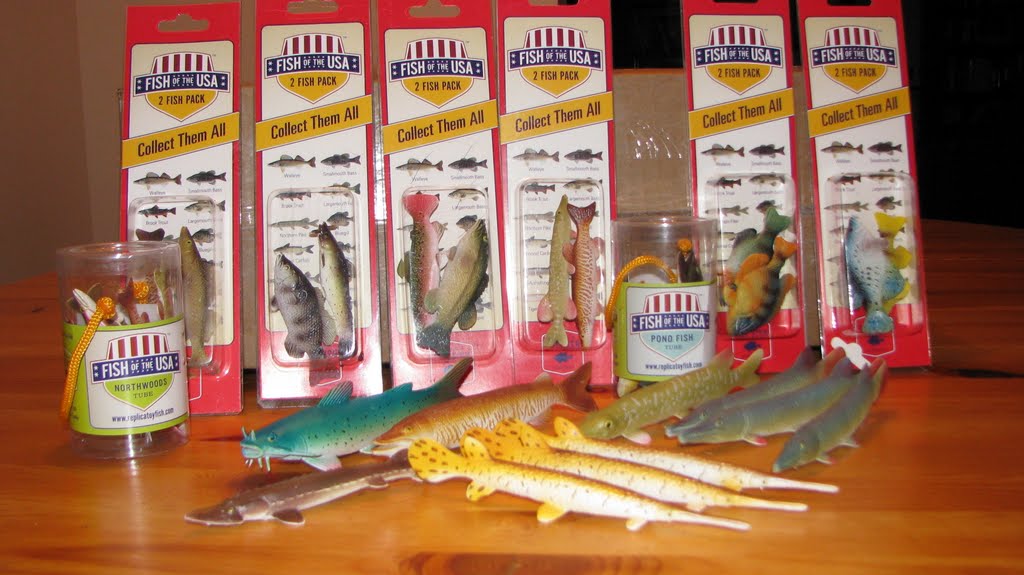
For those who are familiar with the RTF figures, it may sound odd that there are ‘sets’ but in the very first days–that was one way they were sold! I was among the first to get some of these figures, and at the time RTF experimented with a few different ways to market them. I’ll be honest, there were some strong ideas that probably should have carried on. One was a card-backed pair of 3″ fish figures that looked like a fishing lure package, and one the other was the initial twelve 3″ figures in two separate acrylic tube sets, the Pond Fish and the set being looked at here, the Northwoods. I foolishly removed all of my figures from those packages and tossed them, but I do have one remnant photograph:
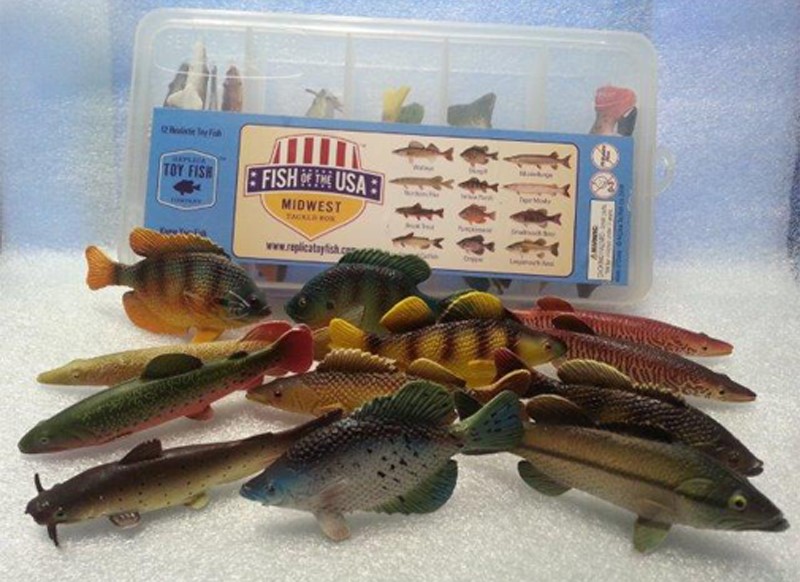
Later, the whole set of twelve small figures was packaged in a tackle box format, which later carried to the Toy Fish Factory modus operandi (which was I think less successful–possibly because there were only five figures in each one…for a retail cost). Speaking of, four of the five species in this set were revised for the Northern Angler set from TFF. This was another pretty good way to present the figures–best of all it listed in photos all of the figures in the set and allowed a person to identify which figure was which fish–overall not difficult, but two in particular could be a challenge (even with the photos…the paint jobs didn’t always match perfectly to the illustrations).

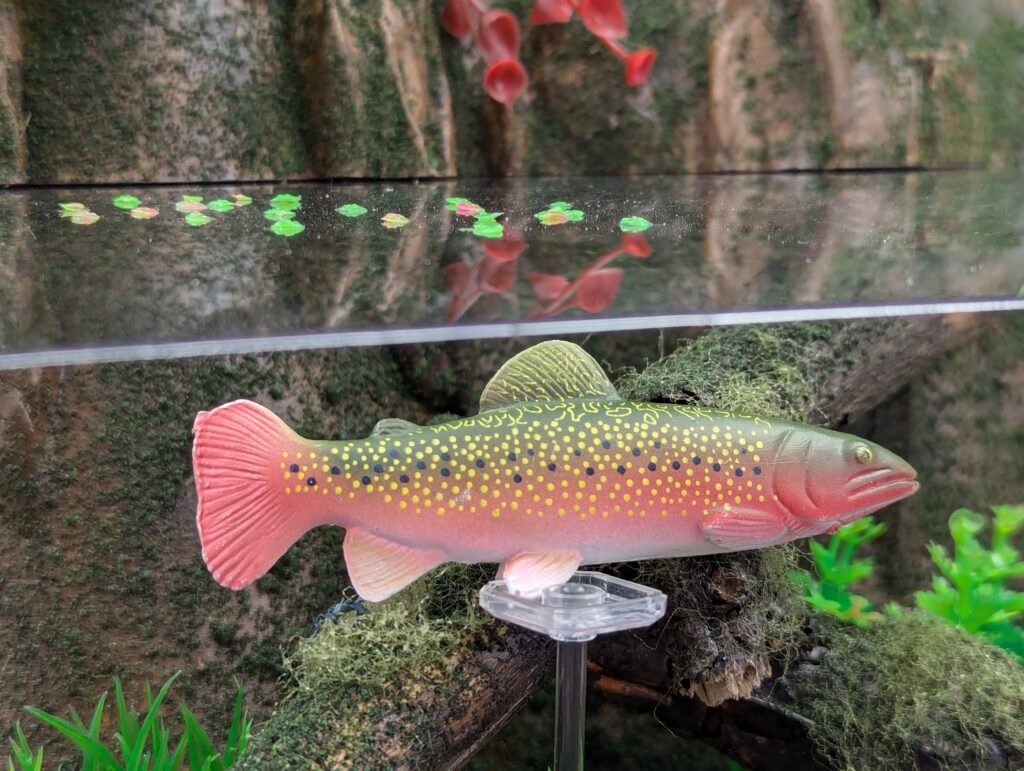
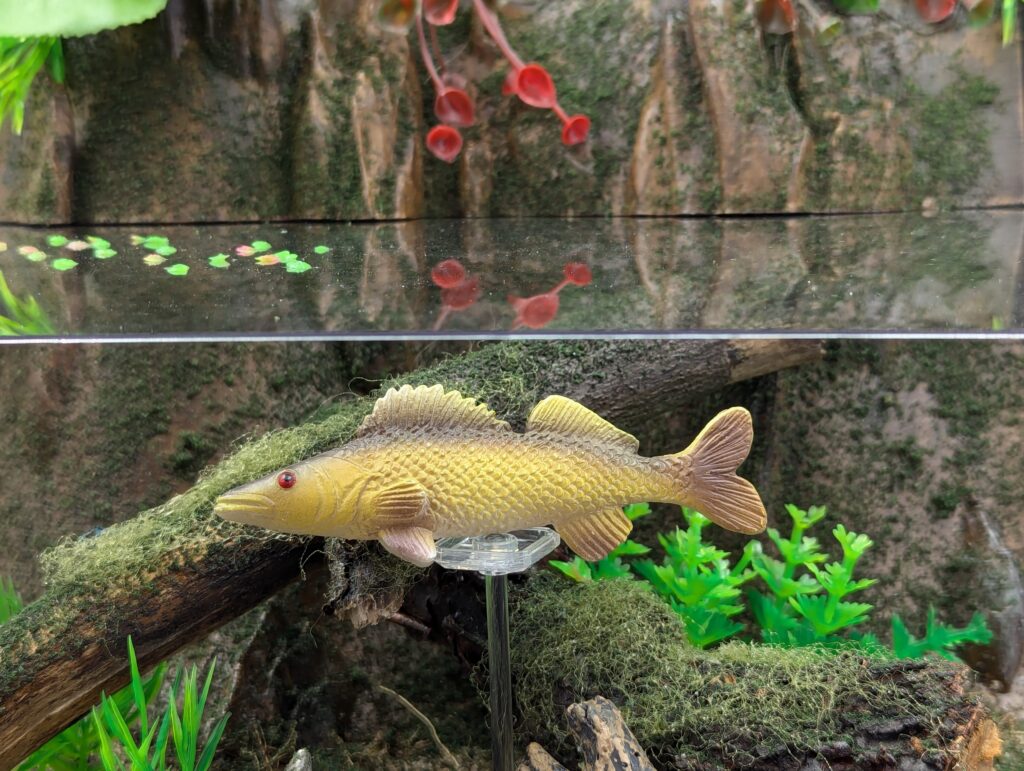
The Northwoods set featured six species (or ‘species’) that are commonly commonly fished for in rivers and streams throughout a good part of more northern areas of North America (one is naturally found more broadly, others have been introduced elsewhere). The species being looked at today are the smallmouth bass Micropterus dolomieu, the brook trout Salvelinus fontinalis, and the walleye Sander vitreus; all of these species are strictly North American natives (at least, originally…) I will look at each one individually. One thing I’ll just point out here, all of the fish are sculpted in a ramrod-straight pose, no curves or bends, and the mouths are closed; I brought this up with the 6″ channel catfish that the figures are not posed in a way to convey activity, but instead to act as reference models (which…sure).
Smallmouth bass Micropterus dolomieu

We’ll start with an especially popular sport fish, the smallmouth bass. Originally found throughout much of the northeast United States and Canadian areas around the St. Lawrence and Great Lakes. In their natural range the smallmouth bass is listed as Least Concern by the IUCN; they are are also invasive or introduced (intentionally or illegally) throughout much of the rest of the United States and southern Canada, as well as much of the rest of the world–Asian, Europe, Africa, and South America! Smallmouth bass are quite resilient, preferring clear cooler water, and more tolerant of faster currents. They are active predators, feeding on most animals that they can catch including amphibians, arthropods, and fish (including smaller smallmouths). They can be fairly big fish, ranging from 25-69cm (10-27 inches), usually 30-50cm.
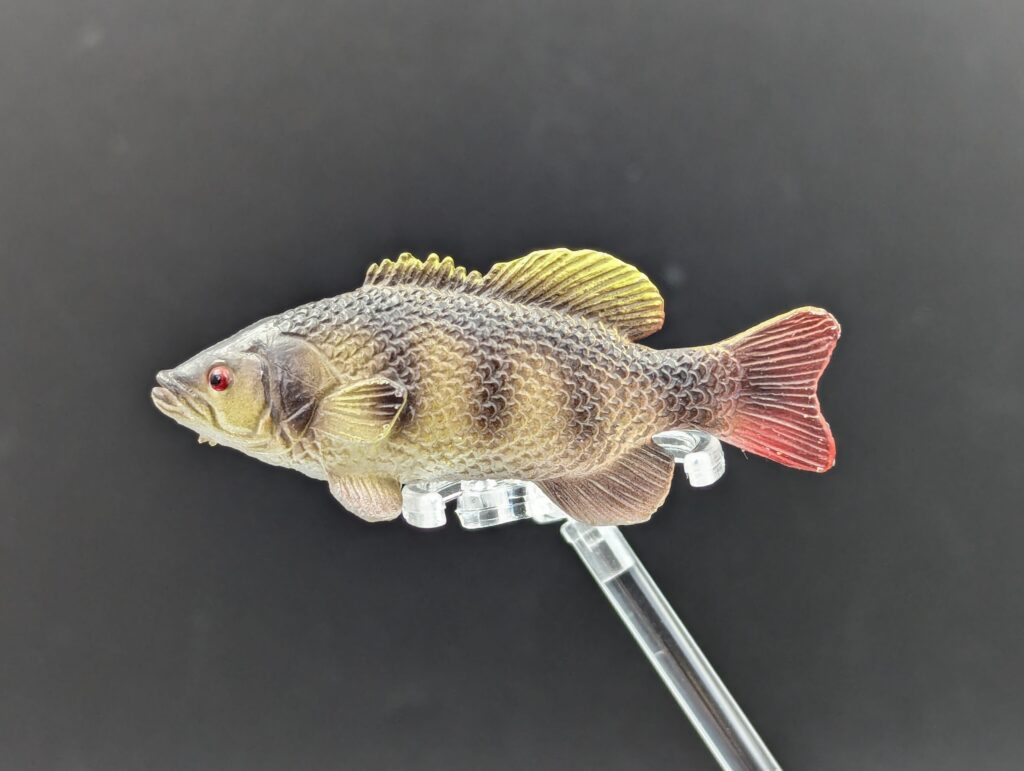

The sculpt is generally decent–the fish is very representative of a bass, with the deep, overall oval body shape. The RTF smallmouth bass is a small figure, around 7.2 cm long, giving a scale of about 1:10. One of the most important things, the rear edge of the mouth ends before the eye, which is characteristic of smallmouth bass. The finnage is indicated well, with the dorsal fin showing the low, spiky anterior and higher, softer-rayed posterior. All other fins have the rays clearly marked. The head is well sculpted, with the opercula and other inscriptions one face distinctly etched. The entirety of the body is marked out in small, overlapping scales.


It is painted with an overall olive body colour, with a darker dorsal margin from the snout through the entirety of the caudal peduncle, and several mostly solid bands down the sides painted a darker brown. The eyes are painted a dark red, with a black centre; the only other red is on the caudal fin. The fins are variously lighter olive or green, and all including the tail have some irregular darker olive washes. The belly is unpainted/white. Overall the paint is reasonably well applied, although there are various patchy spots and missed areas; the eyes are pretty clean though. One big miss is the face colouring; on a smallmouth bass the cheeks should see a radiation of several line, instead of the patch on the face. As well, there should be more, thinner bands that would be less solid and more broken up. It’s not bad, and smallmouth bass do vary quite a bit, but it’s not perfect. The Toy Fish Factory set included a revised smallmouth bass, and I will say that it is more accurately painted.
Brook trout Salvelinus fontinalis

Another well known sport fish, and the only salmonid in the original RTF releases. Brook trout (actually a type of char) are native to eastern Canada and the northern United States. They (generally) prefer clear, clean streams and ponds with good surface cover, and the reduction and degradation of these habitats in their native distribution has caused noticeable declines (although they are more resilient than other char). They are also impacted by introduced species such as brown trout…but in many other parts of North America (like where I live in western Canada) they may be introduced or invasive, and they’ve been introduced to other areas worldwide, with varying success. There are also some coastal populations, clearly these fish are very adaptable! They are opportunistic predators, eating anything arthropods and worms to small mammals that they find in the water. Brook trout are usually 26cm (10inches) in length, but can reach up to 65cm (26 inches) with some bigger records of course. Brook trout are currently listed as Not Evaluated by the IUCN , but there are some populations that are locally endangered in their native ranges.
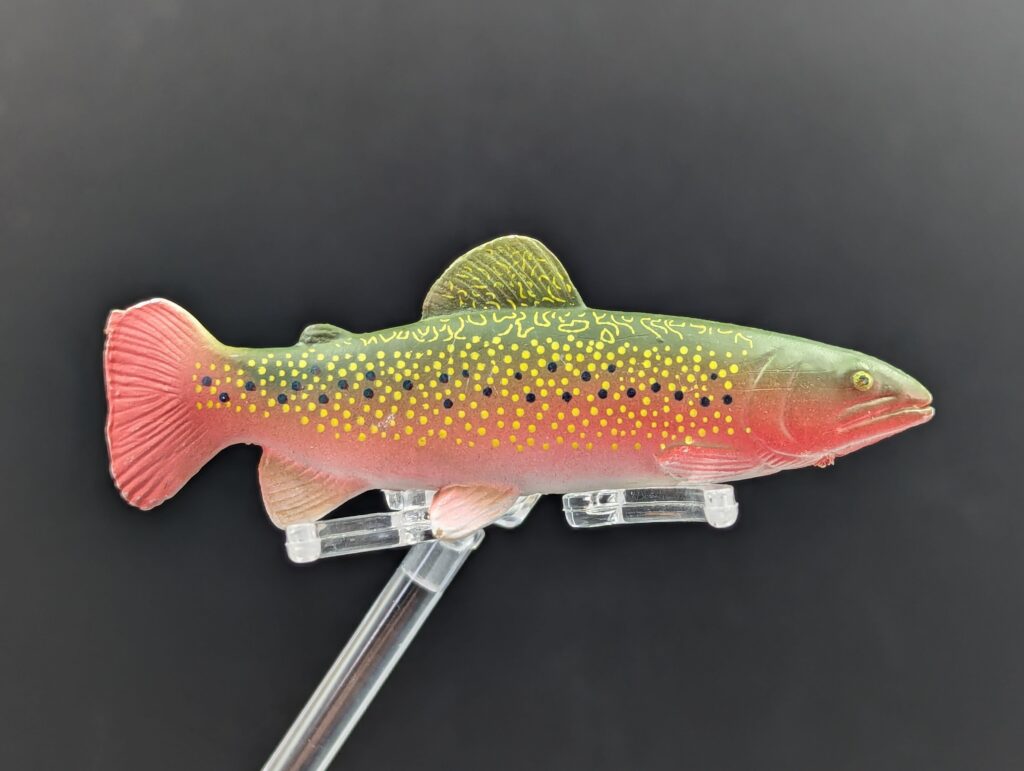
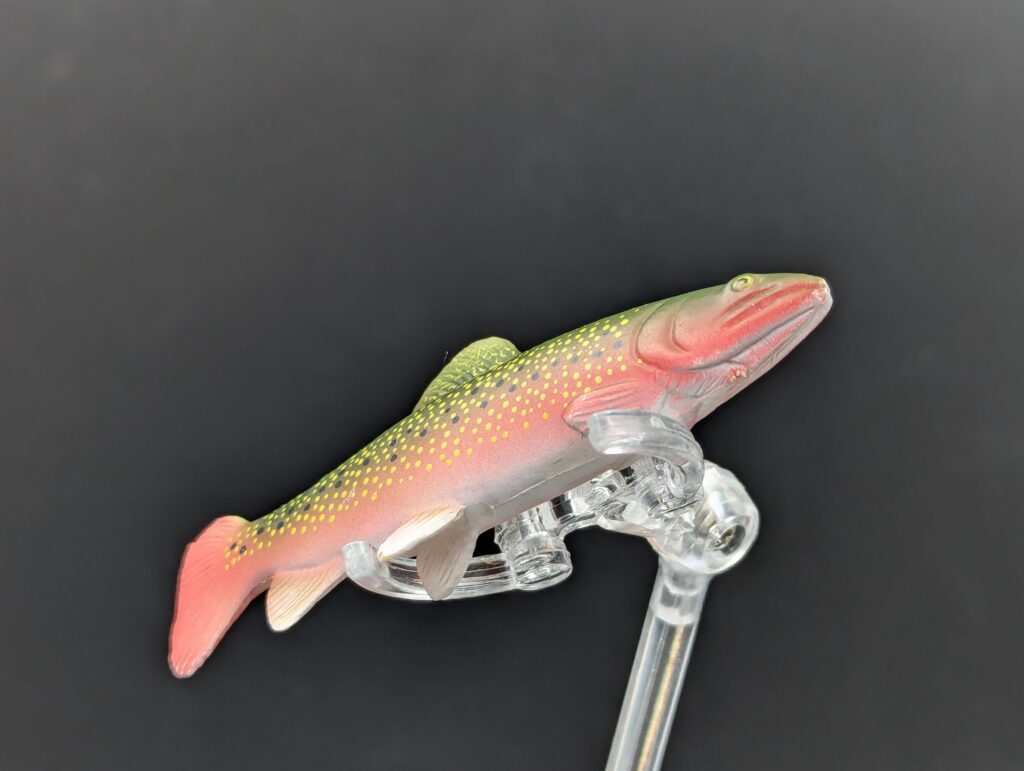
The figure itself is a very smooth fish, with large fins and no scale texture. It is about 8cm long (~3inches) giving a scale of ~1:3 or 1:4 (for a 26cm long fish). The face has a slight downturn to the mouth, but other than the edges of the mouth and the several folds on the lower opercula there aren’t many other markings. The eyes are large and bulge out of the head. The overall body is a pretty typical fusiform trout body shape. The dorsal fin is high and honestly a little too long along the body, followed by a tiny adipose fin. The pectoral fins are sculpted against the body, at the throat, while the pelvic fins are extended out; this causes the fish in display mode to tip forward. The anal fin is also very deep, and also seems a bit too large. The tail fin is symmetrical, but rather than the expected shallowly forked tail for a brook trout, the fin is sculpted as almost a single broad, round fin without tips to the lobes. All fins do have rays sculpted on them.
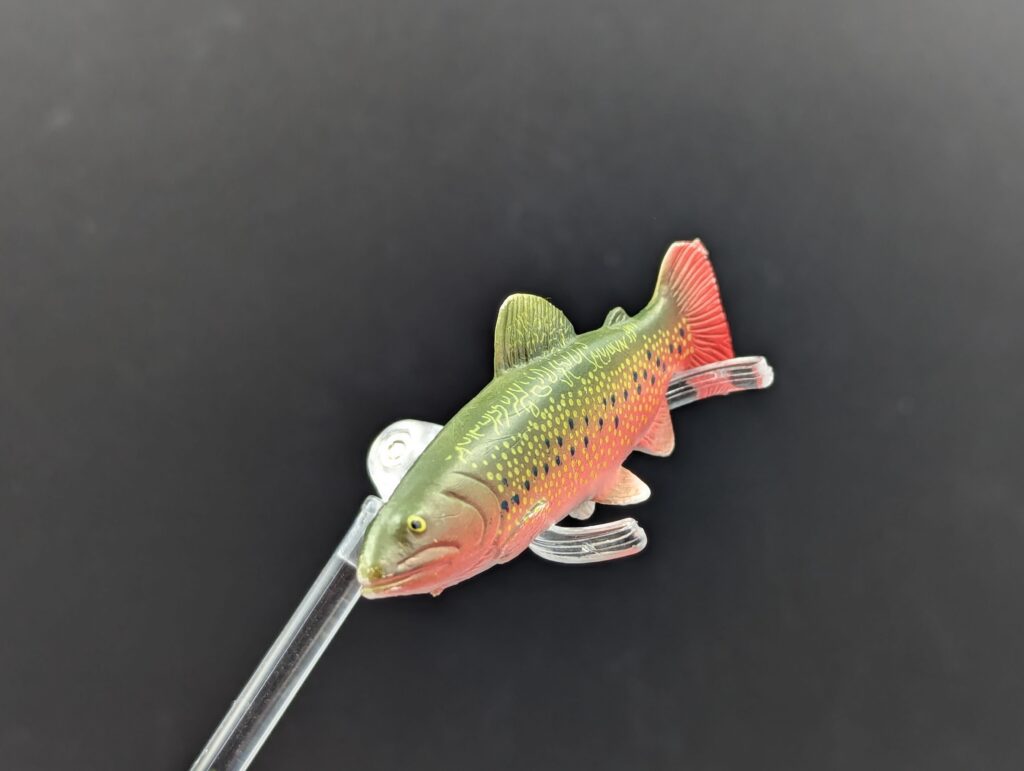

Paint wise it’s…a good try. Brook trout have a pretty complicated overall pattern, and they really did what they could (a later version improved a lot). The overall fish has a dark green back, including the dorsal and adipose fins, to the midline, changing abruptly to pink from the midline down to the belly, which is white. The entire tail and lower fins are also pink. In the real brook trout the majority of the body is green, with only dark red or pink along the belly. The eyes are painted yellow with black centres, and this is done quite cleanly. Along the very back and the dorsal fin are a number of yellow squiggles (called ‘vermiculations’). This is a characteristic feature of brook trouts and can be quite variable, but are usually more like heavy, squiggly markings instead of thin lines. Along the sides are many small yellow dots, and over that are two rows of heavier dark spots. While the yellow dotting is pretty accurate to brook trout, but there should be more pink and even blue spots, often ringed in a lighter halo. To me the biggest miss is that the front margins of the fins are not edged in bright white, which is pretty typical for all char. But overall, it’s a decent small trout figure (it’s no Yujin char figure though…)
Walleye Sander vitreus

The final released figure from this trio, we have a walleye, Sander vitreus, so named for the reflective eyes–I’ll get it out of the way, no, the figure didn’t capture that (instead painting them red). Walleye are naturally found throughout much of Canada and the northern United States in a number of watersheds in a variety of freshwater habitats including lakes, streams and rivers. Their preference for cooler temperatures will often find them seeking deeper areas in the summer. They are active, primarily nocturnal, hunters of a variety of prey including fish, amphibians, arthropods, molluscs, and even birds and mammals if given the chance. They can be fairly robust, commonly 54cm long (22inches) but can reach over a metre (39 inches) with females often larger. Their broad distribution makes them popular for anglers as sportfish and as a food fish, and that also gives them a number of other names, almost all of which refer to them as a ‘pike’ or ‘pickerel’ which they are decidedly not. Their broad range and managed populations has them listed as Least Concern by the IUCN (although a variant, once thought to be a species, then a subspecies, the blue pike or blue walleye, was declared extinct in 1983. Yowies Forgotten Friends made one!)

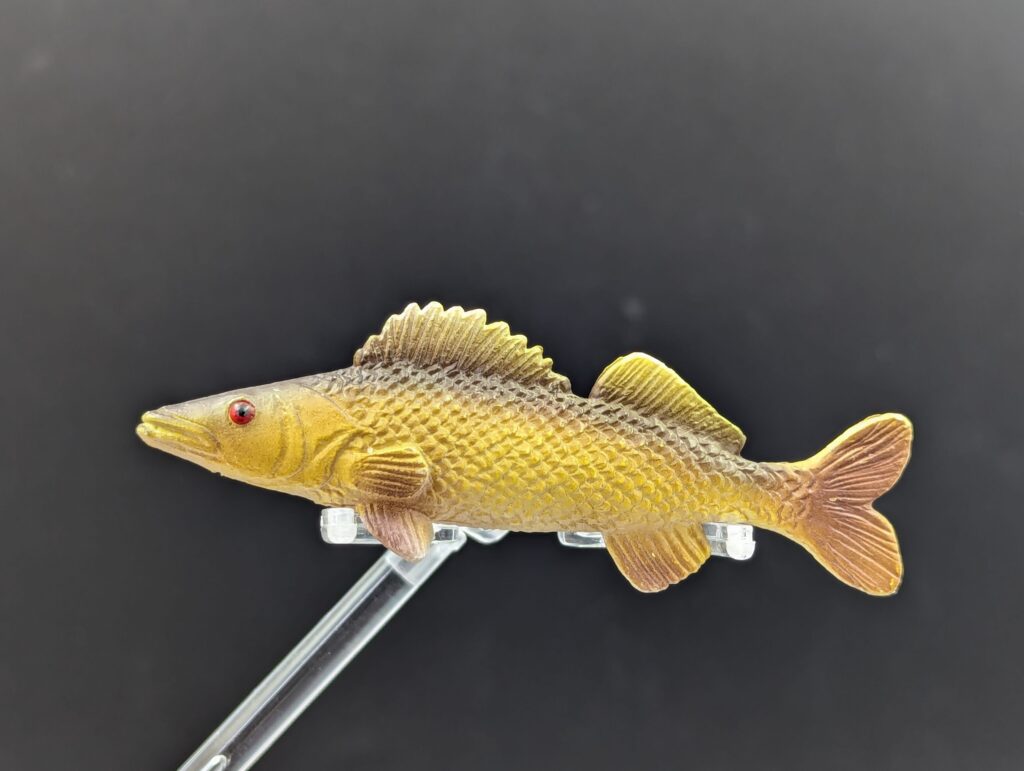
The figure itself is about 7.8 cm (3.1 inches) long, for a scale of 1:7 (for a 54cm fish). The body is elongate and fusiform, with a pointed face and tapered body, ending in a broad, tall tail. In a glance, it represents the shape of a walleye, or other species of Sander, well. The mouth is sculpted with thick lips and a slightly prognathic jaw, expected for a fish that is going to take a variety of prey. The eyes are large and bulbous (and red…this would only be realistic for a fish being photographed at night). The opercula are deeply incised, with a sharp posterior point. The rest of the body is covered in equally-sized rounded ctenoid scales, sculpted to appear to overlap and giving a rough texture. The pectoral fins are sculpted against the body, but the two dorsal, pelvic, and anal fins are extended out. All fins have numerous thick rays, appropriate for a perciform fish; most are finer rays, but the first dorsal is tall and sculpted with thicker, heavier rays ending in points, as it should be. The tail fin, as mentioned, is broad and also sculpted with rays. It is effectively homocercal, also indicative of a fast moving predator, with a deep notch between the upper and lower lobes.


In terms of colour, well, they tried. I won’t mention the eyes again…walleye are also known in French areas as doré, which refers to their shiny golden colour (and also gives them the British English name of dory). The figure is painted as a solid lighter yellow with no notable shine; the dorsal edge of the head and back is a fairly solid dark umber. This umber also extends midway up both dorsal fins, while the paired fins, anal fin and tail are a lighter brown. The tail should see a white blotch on the tip of the lower tail lobe lobe, but this is absent. There are no other markings or splotches on the body, and the belly is white/unpainted. Normally there are darker markings or splotches on the sides but there is a lot of variation. Overall an effective model of a popular sportfish, but the later Toy Fish Factory release did make some improvements (still red eyes though).
Sauger, Sander canadensis
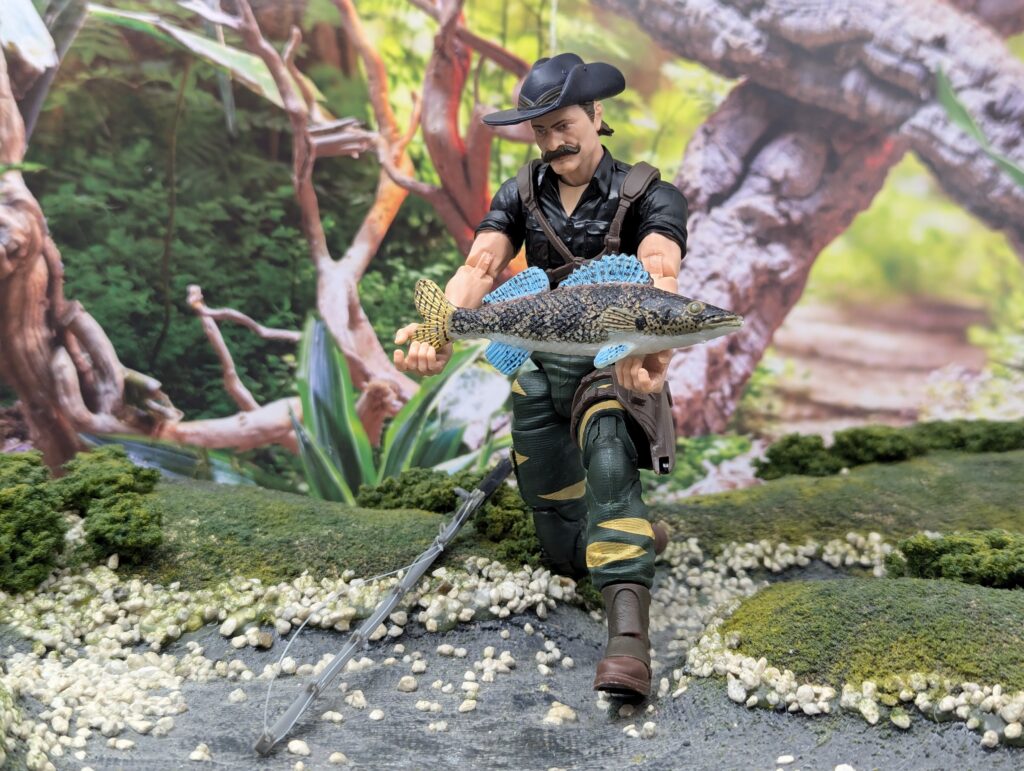
Finally, I mentioned a singular bonus figure. When Replica Toy Fish closed up shop the owner sent me a whole bunch of extra with a last order for my shop. Some were factory seconds, a few were unreleased test models (there’s more out there…and I know who has them…) and some were paint variations, possibly test paints or experiments, never did get an answer. In this instance I received a very unique repaint of the walleye that more closely matches a Sauger Sander canadensis. This fish is very similar in overall behaviour to a walleye, with a range from southern Canada down through the eastern US west of the Appalachians (although their distribution is more fragmented now). They prefer warmer temperatures than walleye, though there is overlap (and they hybridize as “saugeyes”), and are North America’s most migratory fish.
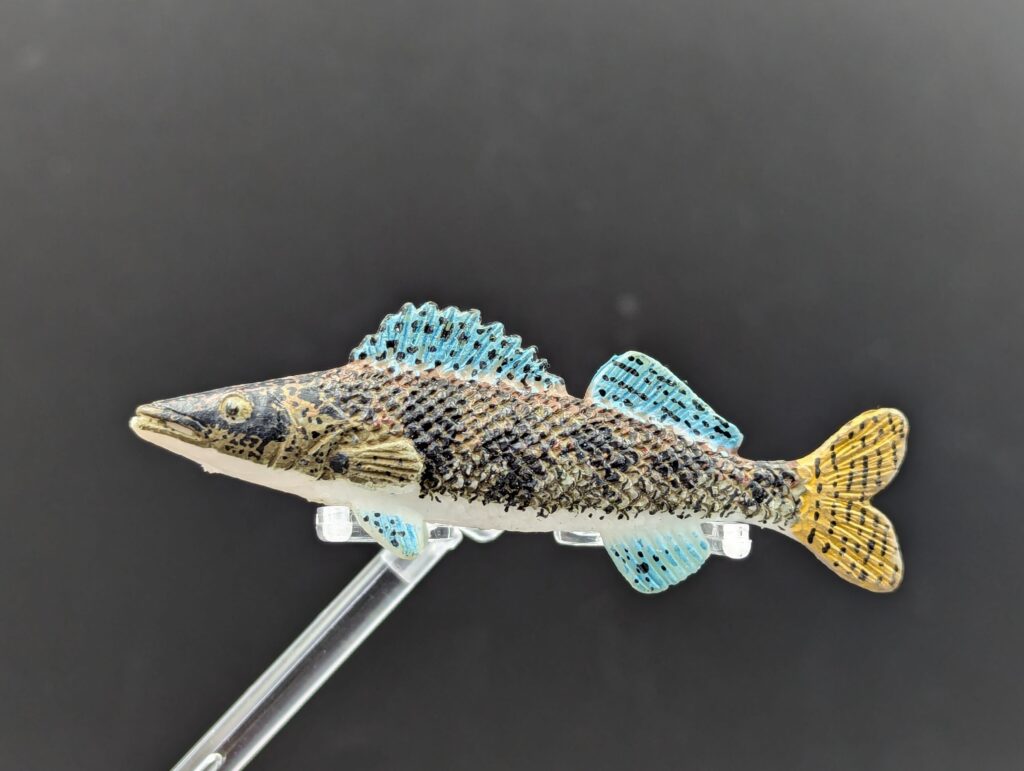
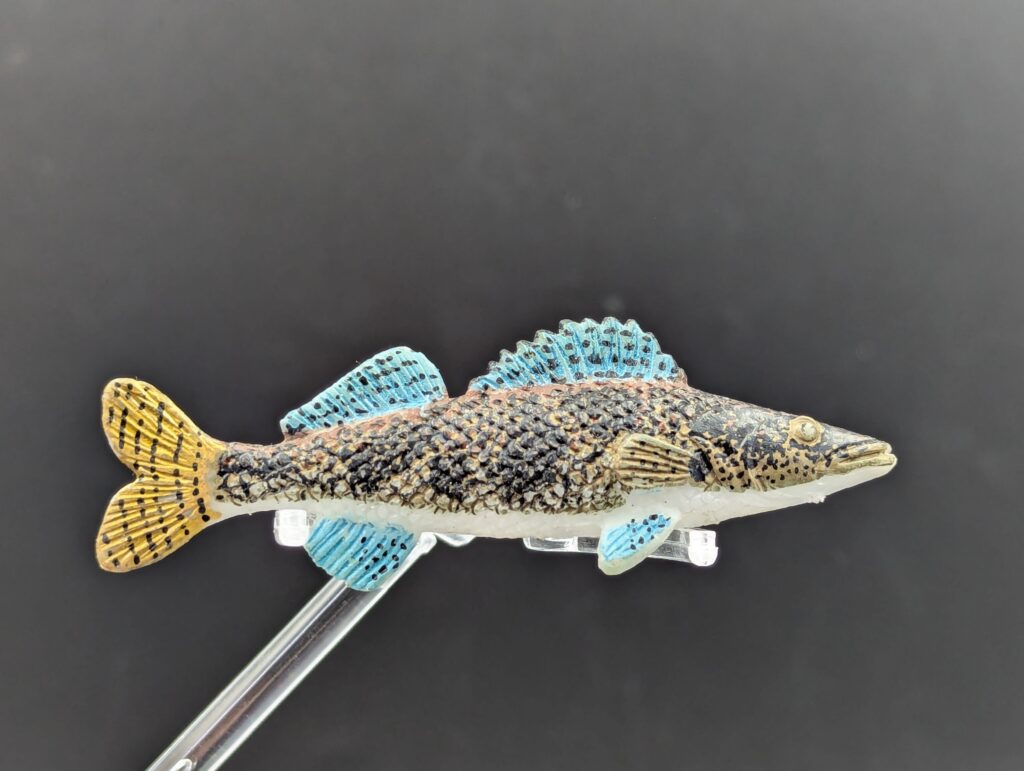
They are also physically similar to walleye in overall appearance with a few notable differences (although both species vary a lot): the overall colour is darker (described as ‘brassy’); there are black spots on the dorsal fin, and there is no white patch on the lower tail–all three of these features were captured well in the repaint. The repaint also added a lot more black barring and splotches, and the fins are highlighted blue; the real fish would have at most a subtle blue sheen but it’s distinctive on the figure! The model is of course the same 7.8 cm long, but sauger are more commonly 36cm long (12 inches) reaching 76 cm, so the figure would range from 1:5 to 1:10. I am pleased to have this little variant, and appreciated receiving it (and others…I’ll bring them up as I go!). Next time…there will be a few six inch figures in advance of the next trio of Northwoods fish.
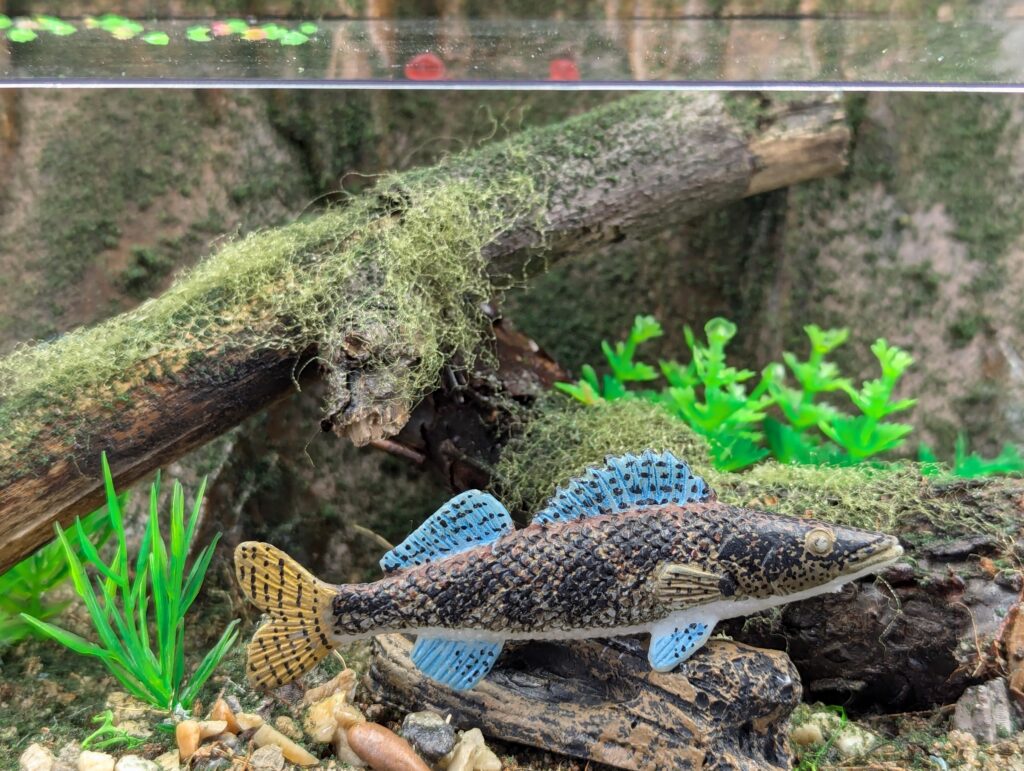
Disclaimer: links to Ebay and Amazon on the AnimalToyBlog are affiliate links, so we make a small commission if you use them. Thanks for supporting us!




The fishing lure packaging is just as appealing as the toys themselves. Would be difficult not to display them that way.
I can’t remember why I opened them. Usually I keep things like that in package.
Didn’t even realize I still had a photo!
Really wish RTF would have stayed with it. Or TFF had gone with it
I really want a Walleye figure! The TFF Northern Angler collection is still available, but not sure I want to buy 6 just for the one.
BTW the first vote for this review was one star. I wonder if that was an error or a bot?
It’s not so bad, the pike is nice (I’ll get to the RTF soon enough).
I can help you with it when our postal service is not on strike. I have several sets left from the online shop